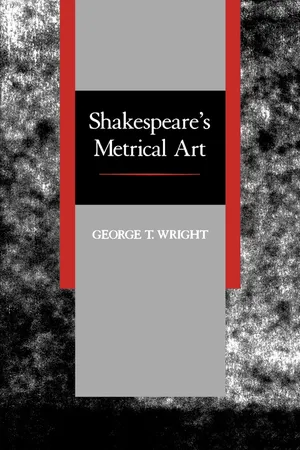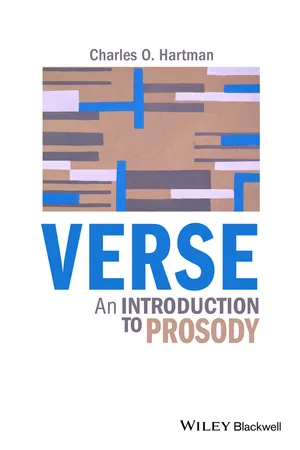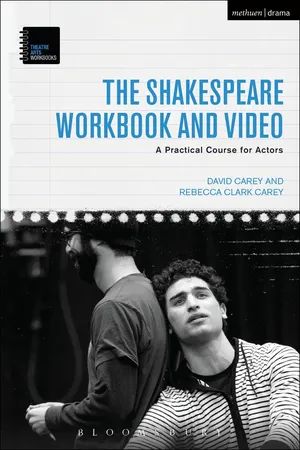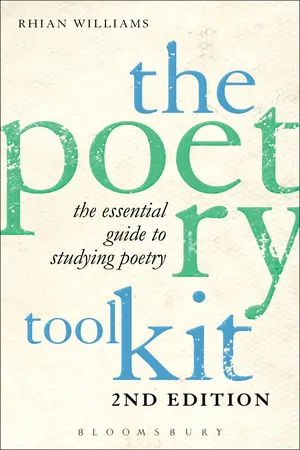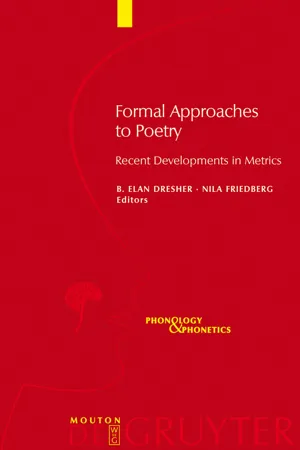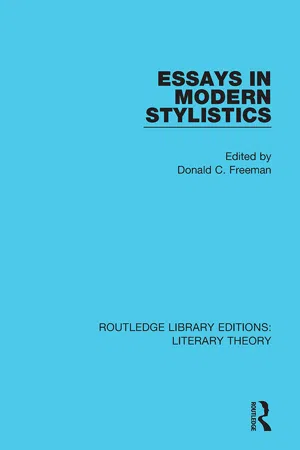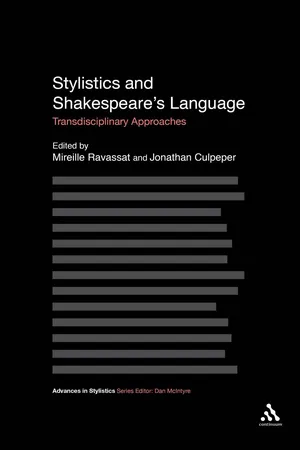Literature
Iambic Pentameter
Iambic pentameter is a poetic meter consisting of five metrical feet, with each foot containing an unstressed syllable followed by a stressed syllable (iambic). This rhythmic pattern is commonly used in English poetry and is known for its natural and flowing cadence. It has been widely employed by renowned poets, including William Shakespeare, in their works.
Written by Perlego with AI-assistance
Related key terms
1 of 5
10 Key excerpts on "Iambic Pentameter"
- Mick Short(Author)
- 2018(Publication Date)
- Routledge(Publisher)
Now let us restrict our discussion for a moment to lines of poetry with iambic ·('di dum') feet. Normally, iambic lines will consist of more than one iamb, and poets can choose how 132 Exploring the language of poems, plays and prose many iambs to have as the basic line-template for particular poems. One particular form has dominated English poetry since the fifteenth-century, however, namely a line with five iambs, as in the following example: Example 2 X I X I X I X I X I Then tooke the angrie witch her golden cup X I X I X I X IX I Which still she bore, replete with magick artes; (Edmund Spenser, The Faerie Queene, I, viii, 14) This kind of line is found throughout the verse of Shakespeare, Milton and Wordsworth, for example, and is called Iambic Pentameter (literally 'iambic five metre'). We might call the Iambic Pentameter line the metrical norm for English poetry from the fifteenth-century onwards. Other possibilities can, of course, be found: 1. Manometer 2. Dimeter 3. Trimeter 4. Tetrameter 5. Pentameter 6. Hexameter one foot line two feet lines three feet lines four feet lines five feet lines six feet lines These 'number of feet' combinations can in principle involve any kind of foot as the basic unit, and various stanza forms can have patterns involving differing numbers of feet from line to line (for example, Keats's 'Song', which we analysed in 2.2. 7, has tetrameters in the first and third lines of each verse and trimeters in the second and fourth lines). But it is the iamb in units of five which is the dominant English verse form. Exercise 1 (a) Re-examine Keats's 'Song' in 2.2.7. What is the rhythmical effect created by having a 'missing foot' in the second and fourth lines? (b) Below are a series of extracts from poems. Work out, for each example, what the basic foot unit is and how many feet there are to the line.- eBook - PDF
- George T. Wright(Author)
- 1988(Publication Date)
- University of California Press(Publisher)
The Iambic Pentameter line, then, has amplitude and asymmetry sufficient to carry significant English speech. What makes it even more speechlike is its uncanny capacity to vary the metrical norm without fun-damentally violating it. Over the centuries poets have experimented with different variations and their combinations, and the results suggest that this line can enter into pacts with almost any metrical devil and still keep its soul intact. By the nineteenth century most poets were willing to try an occasional anapest as an agreeable means of relieving a perceived monot-ony in the standard line, and some twentieth-century poets (for example, Stevens, Lowell, and Larkin) have gone much further in the direction of transforming it into a loosely accentual five-stress line, even into a kind of shadow norm that we sense in poems, such as those of Ashbery, that point-edly steer clear of it. But from Shakespeare's time to the early nineteenth 6 The Iambic Pentameter Line century (and, except for the anapestic variant, to the early twentieth), poets writing Iambic Pentameter habitually permitted themselves to diverge from the meter in three conventional ways in order to give variety, interest, grace, and sometimes expressive character to their lines. Most poets used other means as well—midline pauses and endline enjambments—but these are the three metrical variations that almost every poet writing in English has understood to be standard and permissible. These three variations, with perhaps a fourth that has not been much noticed, are inherent in the structure of iambic meter. At a length as long as pentameter but no longer (not so long as to have to break repeatedly into smaller segments), poets soon found that they could not persistently write lines in which all five stressed syllables were equally stressed and the un-stressed syllables equally unstressed. - eBook - ePub
Verse
An Introduction to Prosody
- Charles O. Hartman(Author)
- 2015(Publication Date)
- Wiley-Blackwell(Publisher)
iamb – a slack followed by a stress.The Names of Meters
The names of meters combine an adjective denoting the dominant kind of foot – such as “iambic” – with a noun that signifies a number (also in Greek!) with “-meter” added to it (because what we call a foot the Greeks sometimes called a “metron”). Here are all the nouns in use:
So “Iambic Pentameter” means a line of five iambs. In practice the extremes of length (1, 2, 8, 9) are rare.monometer mon-o-me-ter a line 1 foot long dimeter di-me-ter 2 feet trimeter tri-me-ter 3 feet tetrameter te-tra-me-ter 4 feet pentameter pen-ta-me-ter 5 feet hexameter hex-a-me-ter 6 feet heptameter hep-ta-me-ter 7 feet octameter oc-ta-me-ter 8 feet nonameter non-a-me-ter 9 feet Now that we’ve plunged into foreign vocabulary, a word about why we use it might be appropriate. This traditional terminology of feet isn’t the only way to analyze meter or metrical lines; it may not even be the most precise. (In Chapter 6 we’ll look at a couple of alternatives.) Its greatest advantage is that it is traditional: poets and readers have been using these terms for centuries, frequently thinking of and hearing lines as composed of these conventional units, and using these names when they want to discuss what goes on in a metrical line. Presumably an Iambic Pentameter that falls in the forest makes the same sound as one that has all its parts labeled, and it’s possible to feel the movement of the line like a dancer or hear it like a musician without knowing the terminology. But to discuss how we feel and hear the lines we read and write, some analytical tools like names are useful. These are the names that lie to hand.If all Iambic Pentameter lines were composed of five iambs, scanning them would be easy but there would be little point to it. In fact only a minority of Iambic Pentameters are exactly regular. There are two main kinds of variation. We’ll investigate “promoted stress” a little later. First we’ll discuss metrical substitution - eBook - PDF
The Shakespeare Workbook and Video
A Practical Course for Actors
- David Carey, Rebecca Clark Carey(Authors)
- 2015(Publication Date)
- Methuen Drama(Publisher)
But what are the characteristics of blank verse that Shakespeare inherited? Blank verse was composed of unrhymed lines in the meter known as Iambic Pentameter . This term, which has come down to us from the poetry of classical Greece, tells us that the metrical structure of each line is based on a rhythmic unit (or foot ) composed of a syllable of weak stress followed by a syllable of stronger stress; for example, the word ‘composed’ would make such a rhythmic unit because the first syllable (com) is relatively weak or unstressed, while the second syllable (posed) is more strongly stressed This type of foot is called an iamb (from the use of this rhythm in Greek satirical poems called iambi ) and it occurs five times ( penta , from the Greek for ‘five’) in a line of Iambic Pentameter. RHYTHM AND METER 113 Take a look at this line from Marlowe’s Tamburlaine the Great, Part Two (Act 3 Scene 2): I’ll have you learn to sleep upon the ground Speak it out loud and notice how the writer has arranged it into a pattern of five iambic feet (the vertical line is used to show the foot divisions): I’ll have| you learn| to sleep| u-pon| the ground We call this a regular Iambic Pentameter line, because the pattern of a relatively weak syllable followed by a more strongly stressed syllable is kept constant over the five feet. But notice that not all the stressed syllables have the same weight: if you say the line quite naturally, it’s likely that learn , sleep and ground have more stress than have and -pon . Similarly, the unstressed syllables are not all equally weak: it’s likely that I’ll and you are more strongly stressed than to , u-, and the . This is because words with more semantic content (or significance) normally take more stress in English than words with little or no semantic content. So, the iambic pattern exists in the relative strength of the syllables in each foot rather than across the whole line. - eBook - PDF
- Rhian Williams(Author)
- 2013(Publication Date)
- Bloomsbury Academic(Publisher)
Each foot is an iamb (described below): the lines can be described as Iambic Pentameters . However, although this poem appears to be very regular and even conserv-ative by sticking to the Iambic Pentameter line, we see that commas actually introduce feminine caesuras (pauses after an unstressed syllable) into both lines’ central foot. So there is something idiosyncratic here, glimpsed within the The Poetry Toolkit 148 apparent calm of the poem. Just as the poem is interested in the visual sense (it describes a person gazing at a scene), so these little pauses are revealed when we visualize the feet on the page. The power that the natural scene has on the poet is even suggested by these tiny pauses, since they threaten to break the iambic feet: the scene is so impressive the poet almost forgets his metrical skill. Note also how foot-divisions do not always coincide with word-endings: words can be split between feet as the metre rather than the words carries sway. In formal verse the number and type of feet per line is uniform (so the line length, the syllable count and the position of the stress in each foot is fixed), and the effect of bringing a series of identical feet together will be considered below. However, even in the most regular verse forms, some alterations occur, in the following ways: � l substitution : when one of the usual feet in a line is substituted with one that has a different stress pattern � l inversion : a type of substitution where the irregular foot reverses the stress pattern seen in the others � l outride : a foot containing extra unstressed syllables � l catalectic line: a line in which one (or more) unstressed syllable is missing; usually this is the final syllable, allowing the line to end on a stress � l hypercatalectic line: a line that has an extra unstressed syllable � l acephalous (from the Greek, ‘headless’) line: when the unstressed syllable in the first foot is missing. - eBook - PDF
- John Singleton, Mary Luckhurst, John Singleton, Mary Luckhurst(Authors)
- 2000(Publication Date)
- Bloomsbury Academic(Publisher)
When you feel ready, you should go on to try sequences of lines each governed by the same principle. The most interest-ing question that arises is whether each line is to be syntact-ically self-contained, or whether the sense will run-on from line to line: • Write ten consecutive self-contained lines, and then ten in which the sense runs on (so that full stops etc. are in the middle of lines). Which set of lines reads aloud better? • What happens if you spread one image over two or three lines? Is it more or less interesting to read? to listen to? Are some images better in one line, and others in several lines? In conclusion -later workshops require more exact ways of shaping and combining lines, but before you begin to do that you need lines to work with! The integrity or coherence (ima-gistic, syllabic, aural, or visual) of lines is a basic feature of all poetry, with which you will be confronting your readers. You can do almost anything, but you always need to know what you are doing -and why! 2 Metrical Lines Metre (the pattern of stressed and unstressed beats in a line) is conventionally analysed as the repetition of a basic unit, called a foot, and the description of a metrical line therefore specifies the type of foot, and the number of such feet per line: thus 172 THE CREATIVE WRITING HANDBOOK Iambic Pentameter means a line of five iambs, trochaic trimeter a line of three trochees, and so on. The great bulk of English poetry uses one of four basic feet: duple feet the iamb ti-TUM or ux iambic the trochee TUM-ti or xu trochaic triple feet the anapzest ti-ti-TUM or uux anapzestic the dactyl TUM-ti-ti or xuu dactylic These feet are most commonly used with between three and seven per line: trimeter tetrameter pentameter hexameter heptameter three feet per line four five six seven trimetric tetrametric pentametric hexametric heptametric These nine terms, in their twenty combinations, can be used to describe most poetry in English. - eBook - PDF
Formal Approaches to Poetry
Recent Developments in Metrics
- B. Elan Dresher, Nila Friedberg, B. Elan Dresher, Nila Friedberg(Authors)
- 2008(Publication Date)
- De Gruyter Mouton(Publisher)
Now we may turn to Frost’s “deviating” lines and see whether some of them are still metrical, or anomalous even for this poet. The problem of metricality is more complicated for English iambs than for their European counterparts, such as German or Russian. First, the most common iambic meter in English is not tetrameter (as in Russian) but pentameter, with its more numerous accentual line variations. Secondly, the creators of the Eng-lish iamb, rst Chaucer, and later Wyatt, learned from French and Italian syllabic poetry and incorporated some of its features, as in Wyatt’s earlier translations of Petrarch’s sonnets. Finally, words in English are short, and there are many stressed monosyllables that often fall on W syllabic positions. Consequently, the English iamb allows a wide range of licenses. 2. Theories of iambic meter American scholars have been discussing for forty years now how to de ne a “well-formed” Iambic Pentameter line. The debate was started by Halle and Keyser (1966, 1971); several other scholars contributed to the discussion, for example, Magnuson and Ryder (1971), and Kiparsky (1975, 1977). Halle and Keyser assumed that at the basis of iambic poetry lies an abstract model, What is “metricality”? English Iambic Pentameter 57 a sequence of alternating syllabic positions W S W S W S..., and that actual lines are generated from the model according to a set of rules. (A similar ap-proach was outlined by Russian “formalists” during the rst quarter of the 20th century (Zhirmunsky 1925, Tomashevsky 1929, cf. Halle’s review of Zhirmunsky’s works in Halle 1968)). Lines that do not comply with the rules were called ill-formed. The formulation of the rules was modi ed several times to account for a wider range of actual lines. 2.1. Stress maxima The earliest theory disallowed “stress maxima” on W (Halle and Keyser 1966, 1971) making a good proportion of actual iambic verse unmetrical. - eBook - PDF
- Donald Freeman(Author)
- 2019(Publication Date)
- Taylor & Francis(Publisher)
1 3 The case of the iambic pentam eter does not appear to us so dissimilar as to rule out an analogous explanation fo r the absence of lines such as (32) in vers es writ ten in Iambic Pentameter. 1 4 ' ' (32) bil lows, billows, serene m1r ro r of the man ne ��c r()_LI__gh s, remote v v v v v v v v w s w s w s w s wil lows I I w s Notes This essay is a shorten ed version of a part of a large r study dealing with English metrics. The fu l l study constitutes the third chapter of Halle and Keyser, English Stres s: Its Form . Irs Grm r rh. and Irs Role in Verse ( Harpe r & Row, 1 9 7 1 ). (Permission to rep roduce material from this hook granted hy publisher.) This work was supported in part hy National Institute of Mental Health Grant No. MH-1 3390-02 and in part hy National Scienc e Foundation Grant No. GS-2005 at Brandeis University. We ish to acknowledge the extremely helpful com-ments of Edward Weismil ler and W. K. Wimsatt. We arc indebted to them for many improvem ents in the expost tion which follows: responsibility for its The Iambic Pentameter 22 ! imperf ections is, of course, our own. For fu l l reference for al l works cited in thes e notes, see the selected bibliography at the end. 2 We usc the term 'syllable ' her e as the equival ent of sequ enc e of speech sounds consisting of one syl labic sound ( vowel') preced ed and followed by any number of consecutiv e nonsyllabic sounds (consonants'). ' In particular, we do not take a position on the vexing question of whether or not utterances can be unam-biguously segmented into syllables. 3 By stressed : yllable we mean her e the syllable that has the main stress in the word: al l other syl lab les in the word are subsumed under the term unstressed'. Thus in the word in1trw nentalitr, the antepenult syl lable will be view ed as stress ed and al l other syllables lumped together as unstressed'. We regr et this imprecis e language, but we see no ready way out of this terminological embarrassm ent. - eBook - PDF
Stylistics and Shakespeare's Language
Transdisciplinary Approaches
- Mireille Ravassat, Jonathan Culpeper(Authors)
- 2011(Publication Date)
- Continuum(Publisher)
The silent beat, represented as ‘’, distinguishes (for example) between the restrictive and non-restrictive relative clauses in a pair like the following: ‘I / spoke to the / wai ter who / brought my / soup’ Shakespeare’s ‘Short’ Pentameters 121 (bringing precedes speaking); ‘I / spoke to the / wai ter, / who / brought my / soup ’ (bringing follows speaking). 3 As Derek Attridge (1982) has sug-gested, silent beats are a typical structural feature of chantable English demotic verse – nursery rhymes, protest chants and so on – where they represent a beat-long pause, a ‘rest’, in the chant. It is easy to clap on the eight beats of an appropriate performance of the following, for example, including on the final rest: /What do we / want ? / Ten per cent ! /When do we / want it? / Now ! / A once well-known football chant goes: /Geor gie / Best ! / Geor gie /Best! /Geor gie! / / Geor gie / Best ! Metrical structure in English is produced through the placement of beats in the spoken line, and this is enabled and limited by three prosodic phe-nomena: by the disposition of lexical and syntactic stress, by the location of syntactic junctures, and by the speaker’s (contextually motivated) plac-ing of pragmatic accent (used for pointing contrast or highlighting infor-mation) within the utterance. To simplify somewhat the argument of an entire book, an Iambic Pentameter is an utterance or part-utterance that can be accommodated (by rule-governed elisions where necessary) to five feet (pairs of syllable-positions), each of which contains at least one sylla-ble capable of carrying a beat, normally the second syllable of the foot. A syllable is prevented from carrying a beat when it is ‘dominated’ by a fully-stressed neighbour within the same intonational phrase; a syllable not so dominated may be called ‘independent’; in ‘my apartment’, for example, fully stressed (and thus independent) -part-dominates both a - and -ment but leaves unstressed my independent. - eBook - PDF
- Peter Robinson(Author)
- 2018(Publication Date)
- Cambridge University Press(Publisher)
The rhythm of a poem is an experience of the patterned sound it makes when read aloud; any identifiable pattern, regularised in hinted at binary alternations of stress, is its meter. As already noted, the meter is an abstract template that can, with varying degrees of plausibility, depending on the complexity of the cases, be identified by analyzing a poem’s lines and phrases. In all but the simplest of jingles, the meter and rhythm, template and performance, are by no means the same. This is because there are more Richard Wollheim draws a distinction between knowing a language and having an artistic style in Painting as an Art (Princeton: Princeton University Press, ), . His distinction, if applied to poetry, is complicated by language speakers having prosodic style in their usage informed by knowledge of lullabies, chants and other folk poetry with what he calls ‘psycho-motor reality’. Seymour Chatman takes it as axiomatic ‘that meter is a species of rhythm’ in A Theory of Meter (The Hague: Mouton, ), . Though he does not confuse the terms, I prefer them separated for clarity of exposition. For an account of why the terms meter and rhythm can be contrasted and where the contrast is inherited from, see John Hollander’s account of the Greek metrikoi and rhythmikoi in Vision and Resonance: Two Senses of Poetic Form (New York: Oxford University Press, ), –. The Sound Sense of Poetry than two levels of stress in naturally pronounced English. Even in jingles the distinct characters of the individual syllables will give variety to the simplification of such sounds into the abstractly alternating ‘ti tum ’ of, in this instance, iambic metrical feet. These feet are similarly abstract inter- pretations attributed to formed phrasings. Intuiting a meter may be necessary, but is by no means sufficient to hearing the poem.
Index pages curate the most relevant extracts from our library of academic textbooks. They’ve been created using an in-house natural language model (NLM), each adding context and meaning to key research topics.

